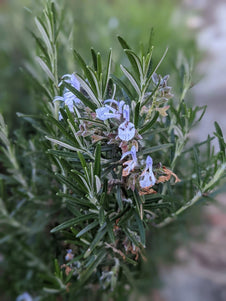









Rosemary - Gorza Rosemary
Rosemary - Gorza Rosemary

- In stock, ready to ship
- Inventory on the way

Usually available: All year
Life cycle: Perennial
Height: 1.4m
Position: Full sun
Soil preference: Well drained
This is how we pack and send your Herb Plants to all states except TAS & WA
You will receive
- 1 Gorza Rosemary Herb Plant in a 50 X 75mm tube - General growing instructions
All of our Herb Plants are grown organically with certified organic potting mixes and fertilizers
Botanical Name: Rosmarinus officinalis 'Gorza'
Rosemary ‘Gorza’ is an upright growing variety, with stiffly held branches giving it a stately but open appearance. This uniquely styled plant may reach up to 1.4 meters high by 1 meter wide. The glossy leaves are green-grey, up to twice as large as other varieties and have a true rosemary fragrance. The large flowers are light lavender blue and appear from mid spring.
The best conditions for growing Rosemary ‘Gorza’ reflect the Mediterranean heritage of all rosemarys. Best results will be obtained from full sun to part shade, well drained soils, and occasional watering after the plant is established. This is a very hardy plant that will do well in dry conditions, tolerate coastal wind and soil, and will also tolerate most frost levels. The best climate is from cool temperate to sub-tropical regions. ‘Gorza’ appears to be somewhat mildew resistant, so some humidity may be tolerated with good air flow.
This variety was named for the northern Italian town of Gorizia, where it was discovered in an herb nursery in the region. The plant may also be called Rosemary ‘Gorizia’ by some gardeners. It is this rosemary that is loved by chefs, especially in Italy, due to the aroma which is described as sweet and soft, with a touch of mint. It is also favoured for the strong branches, which are used as skewers for various meats and other foods, after removing the leaves.
Rosemary General
Rosemary is an evergreen, woody shrub native to the Mediterranean region of Europe. It belongs to the Lamiaceae or mint family, with the botanical name Rosmarinus officinalis. This name is from the Latin words ‘ros’ meaning dew and ‘marinus’ from the word for sea. Together they refer to the ‘dew of the sea’, because these plants grow in near coastal areas. There are many varieties, distinguished by being upright or prostrate, ranging in size from low ground covers to large shrubs reaching 1.5-2 meters high. The leaves are small and often needle like, ranging from green to grey-green with a pine like aroma produced by the essential oils in the foliage. The small flowers are bee attractants and range from pale pink, purple, white, and include a range of distinctive blues. They usually bloom from early spring to summer, sometimes with a new flush in autumn.
Rosemary is a hardy plant that needs little attention once established. Soil should be well drained and slightly alkaline, the aspect should have full sun or partial shade and plants require occasional watering. Rosemary is tolerant of dry periods, coastal conditions, poor soil, hot and windy aspects and even has moderate frost tolerance. Humid conditions, wet soil or excessive frost will cause problems for the roots and foliage. Plants may be pruned to shape, with larger varieties being suitable for hedging. Propagation from cuttings is easy for most home gardeners.
Most people know rosemary as a culinary herb, especially in Italian cuisine. However, this herb also has a history of medicinal use, including being reputed to improve memory. Of course, many gardeners grow Rosemary ornamentally or just for the lovely fragrance it imparts to the garden.
For more information on history, growth conditions, culinary and medicinal use please see our Common Rosemary listing and other varieties such as Tuscan Blue
All information provided on this website is for informational purposes only. Please seek professional advice before commencing any treatment.






